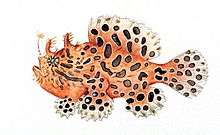Fear of fish
Fear of fish or ichthyophobia ranges from cultural phenomena such as fear of eating fish, fear of touching raw fish, or fear of dead fish, up to irrational fear (specific phobia). Galeophobia is the fear specifically of sharks.[1]
Phobia
Ichthyophobia is described in Psychology: An International Perspective as an "unusual" specific phobia.[2] Both symptoms and remedies of ichthyophobia are common to most specific phobias.
John B. Watson, a renowned name in behaviorism, describes an example, quoted in many books in psychology, of conditioned fear of a goldfish in an infant and a way of unconditioning of the fear by what is now called graduated exposure therapy:[3]
Try another method. Let his brother, aged four, who has no fear of fish, come up to the bowl and put his hands in the bowl and catch the fish. No amount of watching a fearless child play with these harmless animals will remove the fear from the toddler. Try shaming him, making a scapegoat of him. Your attempts are equally futile. Let us try, however, this simple method. Place the child at meal time at one end of a table ten or twelve feet long, and move the fish bowl to the extreme other end of the table and cover it. Just as soon as the meal is placed before him remove the cover from the bowl. If disturbance occurs, extend your table and place the bowl still farther off, so far away that no disturbance occurs. Eating takes place normally, nor is digestion interfered with. Repeat the procedure on the next day, but move the bowl a little nearer. In four or five days the bowl can be brought right up to the food tray without causing the slightest disturbance. Then take a small glass dish, fill it with water and move the dish back, and at subsequent meal times bring it nearer and nearer to him. Again in three or four days the small glass dish can be put on the tray alongside of his milk. The old fear has been driven out by training, unconditioning has taken place, and this unconditioning is permanent.
In contrast, radical exposure therapy was used successfully to cure a man with a "life affecting" fish phobia on the 2007 documentary series, The Panic Room.[4]
Cultural phenomenon
Historically, the Navajo people were described as being ichthyophobic,[5][6] due to their aversion to fish. However, this was later recognised as a cultural or mythic aversion to aquatic animals,[7] and not a psychological condition.
Fear of eating fish
The Journal of the American Medical Association have published a research paper[8] addressing the fears of eating fish[9] because contaminants, such as mercury may be accumulated in fish.
Cases of ichthyophobia
In his autobiography, Italian footballer Paolo Di Canio describes finding that his then teammate Peter Grant suffered from ichthyophobia. During a practical joke, Di Canio describes Grant's fearful reaction after finding a salmon head in his bed.[10] Grant told The Independent that item in his bed was in fact actually a "shark's head" and "to say I got a fright when I put my feet between the sheets is an understatement."[11]
Etymology
The term ichthyophobia comes from the Greek ἰχθῦς - ichthus, meaning "fish"[12] and φόβος - phobos, "fear".[13] Galeophobia comes from the Greek γαλεός - galeos, "small shark".[14][1]
References
- Galeophobia in medical dictionary.
- Michael W. Eysenck. Psychology: An International Perspective, Psychology Press, 2004, p839, ISBN 1-84169-360-X
- John B. Watson (1929) "Behaviorism - The Modern Note in Psychology"
- Tryst Williams. Man cured of 'life affecting' fish phobia. Western Mail, 18 April 2007
- Washington Matthews. Ichthyophobia, The Journal of American Folklore, Vol. 11, No. 41 (1898), pp. 105-112
- William H. Lyon. The Navajos in the American Historical Imagination, 1868-1900, Ethnohistory, Vol. 45, No. 2 (1998), pp. 237-275
- Howard M. Bahr. The Navajo as Seen by the Franciscans, 1898-1921: A Sourcebook. Scarecrow Press, 2004, ISBN 0-8108-4962-3
- Dariush Mozaffarian, Eric B. Rimm, "Fish Intake, Contaminants, and Human Health. Evaluating the Risks and the Benefits", Journal of the American Medical Association, 2006, vol. 296, pp 1885-1899.
- "New Study Shows the Benefits of Eating Fish Greatly Outweigh the Risks" - an overview of the publication by Mozaffarian and Rimm in a press release by the Harvard School of Public Health
- "Time-Tested Guidelines for Eating Seafood" Archived 2011-07-21 at the Wayback Machine, a presentation by Jane Brody (Personal Health Columnist, The New York Times) at the 2005 Seafood & Health Conference, where she coined her own term for fear of fish: pescaphobia, from Latin for "fish"
- Paolo Di Canio. Paolo Di Canio: The Autobiography, Harper Collins, 2001, ISBN 0-00-711598-9
- Ronald Atkin. Grant ready with his shark riposte, The Independent, November 19, 2006.
- ἰχθῦς, Henry George Liddell, Robert Scott, A Greek-English Lexicon, on Perseus
- φόβος, Henry George Liddell, Robert Scott, A Greek-English Lexicon, on Perseus
- γαλεός, Henry George Liddell, Robert Scott, A Greek-English Lexicon, on Perseus
